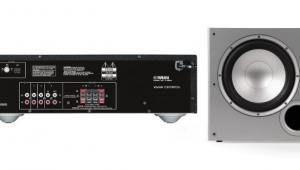What are the patterns on the HD Benchmark disc should you use for testing. I have the Oppo BD-83 and the Pioneer Elite Pro 151HD tv.
RMS, HDMI, RGB

Years ago, I was told that there were several ways to rate the power output from an amplifier, but only one of those ratings was the "true" measure—RMS or continuous power. The Federal Trade Commission (FTC) got into the act back in the 1970s, requiring all amps over 5 or 10 watts to be rated in RMS watts with both channels driven. That requirement was lifted in the '80s, and now when I read power output specs, I don't know if they are RMS (root mean square), IHF (Institute of High Fidelity), or something else. Could you clarify this confusion?
Pete Starsmann
You're right—there are different ways to measure amplifier power, making this is a very confusing issue. Manufacturers often measure the power output of their amps in whatever way will yield the highest number, and there's no way to know which method they used unless they specify it.
Mark Peterson, who performs the audio measurements on review products for Home Theater, has this to say about it: "We measure and publish RMS continuous (100% duty cycle) output with a specified number of channels driven, in the spirit of the original FTC mandate. This is a completely synthetic test, in that it doesn't represent the demands of real-world program material, but it does generally give insight into the capabilities of the oh-so-important (and relatively expensive) power-supply section.
"Beyond reading the fine print and assuming that the manufacturer's marketing department wasn't in charge of the spec sheet, there often isn't enough commonality or specificity in the conditions of the test to meaningfully compare output numbers from different sources. Keep reading Home Theater's amplifier and AVR reviews, and you'll start to see a pattern of manufacturers whose claimed numbers tend to track with what we measure more closely than others."
Time to Upgrade
I currently have a Marantz SR7000 A/V receiver and a Panasonic PT-51DX80A rear-projection TV. I would like to update the TV to an LCD flat panel with LED backlighting, such as the Toshiba 46SV670U. I'm told that I can operate it without HDMI (since the receiver lacks that interface) using S-video instead. I would feed the receiver with an optical link from a Blu-ray player. Will this work satisfactorily, or should I upgrade the receiver?
Gary Lapman
You can use the Toshiba—a very good TV, as Home Theater's review reveals—or any other modern TV without HDMI, but S-video would not be satisfactory for me, especially from a Blu-ray player, because S-video cannot convey high-definition signals. Unfortunately, the SR7000 had no component-video inputs or outputs, so you're not going to see high-definition through it no matter what you do. I would definitely upgrade the receiver to a modern model with HDMI. In addition to seeing high-def on the TV, you'll also hear lossless Dolby TrueHD and DTS-HD audio with no compromise; if you send audio to the receiver via optical, you'll only hear the older Dolby Digital and DTS audio, which loses some audio information in the compression.
Color My Space
As I understand it, YCbCr is a way of encoding RGB information, and it's the way that DVD and Blu-ray discs store video information. Also, by connecting an HDMI cable between a DVD player and an HDTV, the cable carries RGB information to the television. Doesn't this imply that the DVD player is performing the conversion to RGB? So, if you connect component cables, would the YCbCr information be sent to the television, which would then perform the conversion?
My main question is this: where is the optimal place for the conversion to take place? In a player? In an A/V receiver? Or in the HDTV? The TV is likely the most expensive component (and perhaps the most capable) of the group, which might lead me to believe the conversion should be done by the TV. But I've been led to believe we should use HDMI cables in lieu of component cables wherever possible. So what is the best approach?
Alan Goldstein
Great question! You are correct that video information is stored on DVD and Blu-ray in the YCbCr color space, which is a form of data compression applied to RGB. And connecting a player to the TV with component cables does, indeed, convey YCbCr to the TV, requiring the TV to convert that signal to RGB. However, it is not true that HDMI can only carry RGB—in fact, it can carry either RGB or YCbCr. Some players provide a control that lets you select one or the other color space. If there is no such control, the onscreen display of the player or display might indicate which type of signal is being sent.
As for where is the best place to perform this conversion, that depends on the quality of the video processor in each device. Recently, I was talking with Stacey Spears and Don Munsil, the creators of the HD Benchmark setup and test Blu-ray, about this very subject. They pointed out that test patterns let you clearly determine which device in a video-signal chain does the best processing. For example, if you have a player that lets you set the output to RGB or YCbCr, HD Benchmark has several patterns to look at with both settings—if sending RGB looks better on these patterns, the player should do the decoding, but if YCbCr looks better, the display should do it. You can also apply this approach if your AVR or video processor provides similar color-space controls.
Which patterns am I talking about here, and what should you look for? Here's what Spears has to say about this:
"The two primary patterns are chroma alignment and chroma multiburst. Look for delay in the horizontal direction on the alignment pattern. On the multiburst pattern, look at the top left burst; the gradient should be smooth, not stepped. The disc includes sample images that show what happens on both patterns. You also want to look at the last burst on the second row of the multiburst pattern. For example, when you send 4:2:2 into the DVDO VP50/50Pro, it will look nice and bright. When you send 4:4:4 into the DVDO, it will be faint.
"The clipping pattern is also important. It was created to identify a bug in the Silicon Image HDMI transmitter/receiver. If a device uses this chip to color-convert from 4:2:2 to 4:4:4/RGB, it will clip in YCbCr first. If only white is clipped, then it is the bug. The reason it works is because the RGB boxes all fall within 16-235 in YCbCr and outside when converted to RGB. The white box extends above 235 in YCbCr. If white is okay but RGB are clipped, it's probably a color-decoding problem or color is set too high. If green is clipped and everything else is okay, it is most likely 601 color conversion instead of 709."
If you have a home-theater question, please send it to scott.wilkinson@sorc.com.
- Log in or register to post comments

If Gary is happy with his Marantz SR7000, wouldn't it be cheaper for him to get the Toshiba TV with an Oppo BD-83 and connect the Blu-ray player to the TV via HDMI and use the 6 analog audio cables to connect the 5.1 channel sound to the 6-channel input of the Marantz? BD-83 can internally decode DTS-HD MA & Dolby TruHD. While upgrading to an HDMI-supported receiver may yield better sound, it may not be the most economical solution.

I agree with Ed L's comment. I had my LCD HDTV and Blu-Ray player for 11 months before I upgraded my ten-year-old A/V receiver to one with HDMI switching. I connected the Blu-Ray player and my new HD satellite receiver to the TV with HDMI cables, the player to the receiver with six audio cables, and the satellite audio output to the A/V receiver with an optical cable. I was thus able to get the full hi def experience and good audio with the only downside being the extra remote control operations required to switch between my satellite receiver and the Blu-Ray player. Audio lip sync also was a bit off with this set-up but over-all I got an enjoyable HD experience. The new A/V receiver did bring me more-convenient switching, better lip-sync and better audio processing options that I am very happy with.

Ed and Roy, you are correct that Gary could get a Blu-ray player that decodes Dolby TrueHD and DTS-HD to its multichannel analog-audio outputs and connect them to the SR7000, which does have corresponding inputs. He would then connect the player's HDMI output directly to the TV. I didn't recommend that because I think he'd be better off with a new AVR. For one thing, I hate having to switch both the TV and AVR; also, I hate dealing with all those cables. But in retrospect, I should have included this option in my response; as you point out, it is less expensive since he's going to get a Blu-ray player anyway. Thanks for bringing it up!

Derrick, reference level is defined by the sound pressure level that a system can produce, not the amp power. In a home theater, the reference level is defined as 75dB SPL, and the only way to determine if the system can play at that level is to use an SPL meter while playing wideband pink noise. This is how an audio calibrator sets the system's level control, which can then be turned down if it's too loud for the user (which it usually is).

hi!i have an old hdtv.(rear projection-46" philips)it accepts only vga , rgb , YCbCr/y pb pr with h v sync. (for hd images)it has a capability to take up to 1080i/p but it doesnt have de new inputs of hdmi or dvi the new equipment i wish to buy has only outputs like hdmi,dvi,composite.is there any way i can enjoy my old tv (that love )in hd using these new inputs?perhaps buy a cable thats called hdmi to rgb/vga? or any other way?pl help!anyone! :)
























































